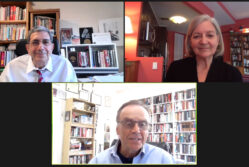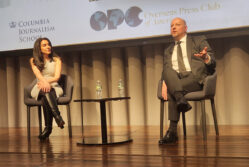
Tucson Panel Discussed Stifled News and Lost Lives
Watch a recording of the panel >>
The panel discussion at the University of Arizona was a launch of the new Center for Global Journalism. Panelist Ricardo Sandoval, veteran Latin American reporter and human rights researcher, told the audience that smuggling Mexicans into the U.S. used to be a mom-and-pop business. However, since 1995 when the U.S. legislated stopping immigration and recently has ratched up its war by putting up a fence and tightening the legal screws on immigration, the business is now in the hands of organized crime. He said he likes to think of the area between Mexico and the U.S. as a “Seam” — an area of coexistence — instead of what it has become: a war zone.
Giannina Segnini, until recently an investigative reporter for La Nacion in Costa Rica, has experienced threats and physical harm from her research on corruption. There are different kinds of psychological borders and she wanted to convey the fact that the traditional journalism where you “own the story” is dead. Investigative journalism has become a team effort if you are entering the field of “big data,” which needs programmers, researchers and reporters.
Moderator Bill Schmidt, recently retired as deputy managing editor from The New York Times, spoke about the difficult circumstances that he had to deal with when reporters are kidnapped or maimed. During all of WWII, The Times lost two reporters, but now there is constant danger.
Mort Rosenblum, who has covered 200 countries, said that years ago you “had to have bad luck or were pretty stupid” to be captured. Mort talked about his surprise when he was held for a few hours in a small island nation. He said that there were three goons — the official goon, the head guy who was fingering his sidearm and then the tech-savvy goon who had a Google print out of Mort’s career — that was a game changer.
The discussion also reached into other problems in foreign correspondence like lawless areas controlled only by mafia-style cartels or political entities that have closed down areas of the world where old-fashioned reporting is impossible. Panelists talked about the problem of relying on fixers and local journalists. The locals are the best equipped to know the story, but they can also be listening for the local government or business. Sandoval told of opening the Havana bureau for the Dallas Morning News with an assistant that was in the employ of the Cuban military. Schmidt spoke of fixers that escort a reporter safely across the border into Syria are now becoming co-opted by the jihadists and were often the ones who set up the kidnappings.
OPC member Don Underwood and his wife Pat live in Tucscon and invited us to their home. Don was eager to show us his photography gallery. Mort Rosenblum, Giannina Segnini, Ricardo Sandoval and I were riveted by the world-class pictures signed by photographers with good wishes to Don who worked for Life magazine for 10 years.
Among the most famous photos is the one of General Douglas MacArthur coming ashore in the Philippines in 1945 at the end of WWII taken by Carl Mydans. Yousuf Karsh signed two 50-year retrospective posters of Hemingway and Churchill. The most well-recognized picture was taken by Alfred Eisenstadt in Times Square of the sailor kissing a young lady. Life editors said it was the most famous and beloved picture ever to appear in Life magazine…”it sings of joy, triumph and America.”



